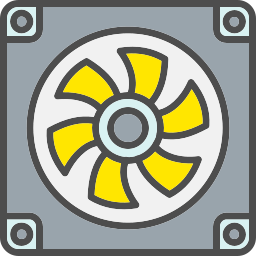
Fan / System Cooling in Computer Hardware Components
System cooling is an essential aspect of computer hardware design and operation. Without effective cooling mechanisms, the internal components of a computer can overheat, which leads to reduced performance, potential hardware damage, and decreased system longevity. One of the primary solutions for maintaining optimal operating temperatures in a computer system is the use of cooling fans and other system cooling hardware components.
Purpose and Functionality of System Cooling
System cooling serves multiple functions within a computer system. The core objective is to dissipate heat generated by the central processing unit (CPU), graphics processing unit (GPU), power supply unit (PSU), motherboard, and other critical components. As these parts process data and perform calculations, they generate heat. If this heat is not removed efficiently, it accumulates and causes the temperature within the case to rise, leading to thermal throttling or in some cases, system failure.
Types of System Cooling Components
Air Cooling Fans: The most commonly used cooling method. These fans are installed in various parts of the computer case, including the front, rear, top, bottom, and sides. They draw in cool air from the outside and expel hot air from inside the case. Specific fans are also mounted on the CPU heatsink and GPU to provide direct cooling.
CPU Coolers: These are dedicated cooling systems installed directly onto the CPU. They typically consist of a heatsink combined with one or more fans. The heatsink draws heat from the CPU surface, while the fan dissipates it away from the component.
GPU Coolers: Graphics cards usually come with built-in fans or cooling modules to manage the substantial heat they generate during gaming or graphical processing tasks. Some high-end GPUs may also support liquid cooling solutions.
Case Fans: These fans are attached to the chassis of the computer and help maintain consistent airflow throughout the case. Proper placement of case fans ensures balanced airflow, avoiding heat buildup in specific zones.
Power Supply Unit (PSU) Fans: Most PSUs include built-in fans that keep the power supply cool during operation. Efficient PSU cooling contributes to overall system stability.
Liquid Cooling Systems: These are more advanced and efficient cooling solutions that use a coolant to transfer heat away from components. They include a pump, radiator, tubes, and a water block. Liquid cooling is often used in high-performance computers or overclocked systems where air cooling is insufficient.
Chipset and VRM Heatsinks: Motherboards often include passive cooling in the form of heatsinks over voltage regulator modules (VRMs) and chipsets. These components manage power delivery and can become hot during intense computing.
Hard Drive and SSD Cooling: Although solid-state drives (SSDs) typically produce less heat, some high-speed NVMe SSDs require cooling to maintain optimal performance. Heatsinks or dedicated fans may be used.
Applications of System Cooling
Enhancing System Performance: Cooling maintains a stable environment that allows the processor and other components to operate at peak performance without throttling.
Extending Hardware Lifespan: Reducing thermal stress helps prevent premature hardware failure, increasing the lifespan of expensive components.
Overclocking Support: Cooling systems are crucial for users who push their hardware beyond manufacturer specifications. Without proper cooling, overclocking can be dangerous to system health.
Quiet Operation: Certain cooling solutions, especially high-quality fans and liquid cooling systems, are designed to operate silently while maintaining effective heat management.
Thermal Management in Compact Builds: In small form factor PCs, airflow is restricted, making efficient cooling solutions even more essential to avoid overheating.
Free or Paid Usage
System cooling hardware is not free. All physical cooling components, whether basic or advanced, are purchasable hardware items. However, some systems may include basic cooling (such as stock CPU fans or standard case fans) with the purchase of other components. For example, CPUs often come with a stock cooler included in the package. Advanced cooling solutions, including high-performance air coolers and liquid cooling systems, must be bought separately and are often priced based on their build quality, efficiency, and brand.
Comparison of Cooling Solutions
Air cooling is typically more affordable and easier to install. It suits most general-purpose computers and even moderate gaming or workstations. Air coolers require regular cleaning and may be bulkier, especially high-performance models.
Liquid cooling provides superior heat dissipation and is ideal for high-end systems, but it is more expensive and complex to install. It can offer better aesthetics, reduced noise, and lower CPU/GPU temperatures, especially under heavy workloads. However, it requires careful maintenance to avoid leaks or pump failure.
Passive cooling, using only heatsinks without fans, is completely silent but limited in performance. It is used in low-power systems or special environments where noise must be minimized, such as audio production studios.
Conclusion
System cooling is a vital aspect of maintaining and optimizing a computer’s performance and longevity. It involves various hardware components designed to manage heat and ensure stable operation. From simple case fans to complex liquid cooling setups, each cooling solution plays a specific role in heat management. The choice between different cooling methods depends on the user's needs, system workload, space constraints, and budget. Although these cooling tools are not free and must be purchased, they are essential investments for anyone seeking reliability and performance in their computing experience. Effective cooling ensures that a system can perform at its best without risking hardware degradation due to overheating.












